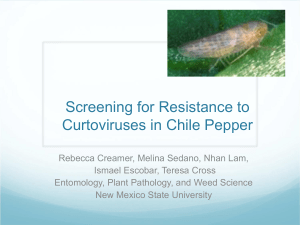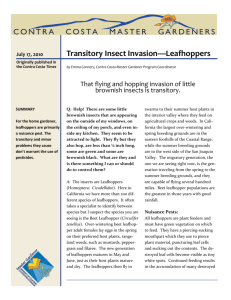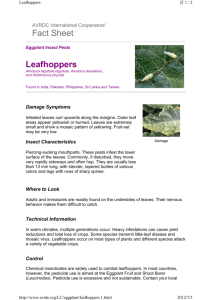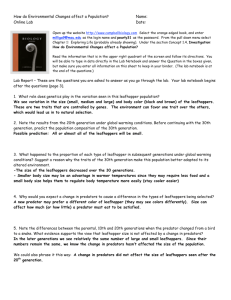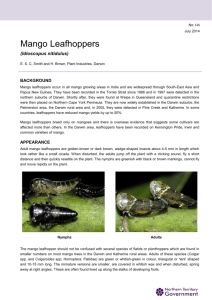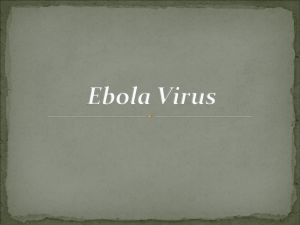Non-Preference Feeding Of Beet Leafhopper on Tabasco Pepper as
advertisement
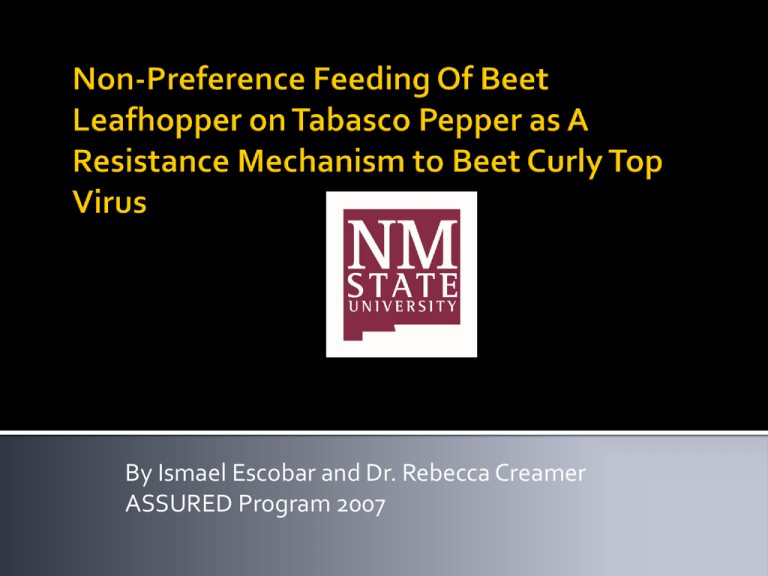
By Ismael Escobar and Dr. Rebecca Creamer ASSURED Program 2007 A problem in the USA since 1899 Infects crops and weeds The crops are peppers, tomatoes, sugarbeets, spinach, melons and beans Youngest plants most susceptible to infection Transmitted by the leafhopper Disease reported in peppers in NM in 1927 Severely stunted plants Some plants have chlorotic rolled leaves Small rounded fruit Stiff plants with brittle leaves Symptoms appear 1-2 weeks after infection Plants infected when young may die Feeds on a wide host range of plants Prefers semi-arid and arid areas Can transmit viruses to plants on which it can’t complete its life cycle 3-3.5 mm length Robust with lots of spines Light tan to yellowish to gray Color and size vary slightly with season Found throughout western USA 3 morphs - summer, winter, and migratory Transmits virus in a circulative manner Can acquire virus after feeding for 15 min, but with longer feeding (48 hr) acquires more virus Can transfer virus to healthy plant with few minutes of feeding, but transmit better if longer Can continue to transmit the virus for days Requires 4 hr latent period in insect before transmitting Heavy seeding Weed removal Plant resistance in bean, sugarbeet, tomatoes, none in chile Kaolin sprays Insecticides - to decrease leafhopper numbers Predictive model To determine the preference of the Beet leafhopper between Tabasco and NM64. The NM64 is going to be the more susceptible to be affected by the virus. Commercial varieties susceptible to, other Capsicum species appear to have some level of resistance. Tabasco vs. NM64 Plants were grown in greenhouse Cotyledons were caged in sets of 4 with 5 leafhoppers for 19 hours. After 2 weeks plants were set for staining, DNA extraction and PCR. Leaf Staining (Acid Fuschin) Confirmation by microscope by staining stylet tracks and punctures Examined 1 leave/plant Extraction/PCR PCR using CP4r & CP6f Tabasco plants with leafhoppers had an average of 6.3 punctures per leaf and the range was from 0 to 28. Stylet tracks had an average of .14 NM64 with leafhoppers had an average of 15.6 punctures per leaf and the range was from 6 to 33. Stylet tracks had an average of .2 None of the plants with leafhoppers tested positive to Curly Top Virus. Tabasco plants without leafhoppers had an average of 0.4 punctures per leaf and no stylet tracks. NM64 plants without leafhoppers had an average of 2.8 punctures per leaf and no stylet tracks. None of the plants without leafhoppers tested positive to Curly Top Virus. NM64 had a higher number of punctures than Tabasco due to preference of the leafhopper. Plants without leafhoppers had punctures due to white flies in the greenhouse.
